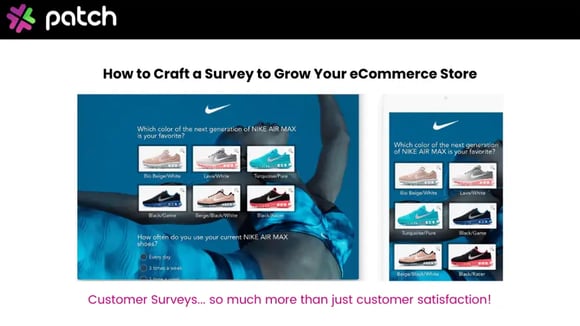Unlocking The Power of Abandoned Cart Recovery with Patch Retention
Unlock customer retention with Patch: Revive abandoned carts, bolster retention strategies, and drive e-commerce success!
Drive your eCommerce success by earning how to craft the perfect customer survey with questions that provide actionable insights and drive growth.

Are you looking to grow your eCommerce store but don’t know where to start?
Conducting market research is the key to any successful business, and eCommerce is no exception. But research is a broad and difficult topic, so it’s best to focus on the most impactful strategy: Surveys.
By the end of this article, you’ll be armed with all the knowledge you need to conduct your own market research and see real growth in your eCommerce store.
So let’s get started!
| TLDR Key Takeaways |
| – A market research survey aims to get answers to all those important questions you have about your target customers and their needs. – Finding a balance between primary and secondary sources is the key to getting the most comprehensive understanding of your target market. – To guarantee that your survey is comprehensive, you need to mix up the types of questions asked so it captures both demographic information and honest customer feedback. |

Before you can craft an effective eCommerce survey, you need to know what your market research will help you answer.
Market research in eCommerce is intended to generate actionable insights that your company can use to grow. For this process to work effectively, it’s essential to know who your customers are and what they want from your business—enter market research surveys.
A good market research survey will help you answer key questions about your target customers, their needs and wants, and the feasibility of your proposed product or service. Here are the main questions your survey should answer.
This is probably the most important question you can answer with market research. Knowing your target market will help you focus all your marketing efforts and ensure you’re reaching the right people.
You may think you already know the answer, but sometimes the results of true market research will shock you.
For example, you might think your target market is women aged 18-24, but after conducting market research, you find that the majority of your customers are actually men aged 25-34.
This information would obviously change the way you market your store.
Again, this is a question that will help you focus your marketing efforts. If you know where your target audience is, you can make sure you’re advertising in the right places and using the right channels.
For example, if you know that most of your target market is on Instagram, then you need to make sure you have a strong presence on that platform.
Knowing the size of your target market will help you understand how much potential there is for growth.
If your target market is small, then you might need to look at ways to expand it. On the other hand, if your target market is large, you know there’s a lot of growth potential, and you can focus on strategies to capture a larger market share.
This is an important question because it will help you understand how much money you can realistically expect to make from your target market.
For example, if you know that the average order value for your target market is $100, then you know that you need to generate 10 orders to make $1,000 in sales.
On the other hand, if you know that the average order value for your target market is $50, then you need to generate 20 orders to make $1,000 in sales.
Now that you know the overall questions you’re trying to answer with your research, it’s time to look at the ways in which you collect this information.
There are two main ways to conduct market research: Primary and secondary. Here’s a chart that breaks down each type of research.
| Type of Research | How It’s Collected | Advantages | Disadvantages |
| Primary | You collect data yourself through surveys, interviews, focus groups, or even just casual conversations. | This is the best way to get detailed information about your target market. | It can be time-consuming and expensive to acquire. |
| Secondary | You collect data from existing sources, like books, articles, reports, or even other people’s primary research. | It’s a quick and easy way to get a general understanding of your target market. | The information you can get from this type is not as detailed or specific as primary research. |
The best way to conduct market research is to use a mix of both primary and secondary research, as it will give you the most comprehensive understanding of your target market.
While the process of conducting secondary research is pretty straightforward (you just find what’s out there), it’s harder to conduct highly valuable primary research since it requires you to interact directly with your target market.
Let’s look at the best ways to do it.
There are many ways to collect primary data, but surveys might be one of the most efficient.
Surveys allow you to access essential demographic information about your target audience that you can use to improve your marketing strategies. They also offer invaluable insights into your business or products/services through honest customer feedback.
To make sure your survey is effective, there are a few things you need to keep in mind:
To ensure that your market research survey provides the information you need, it’s important to know what type of questions are going into it.
This part might seem like a difficult task, but don’t worry! There are actually some really easy ways to do this successfully and effectively.
First, let’s look at the ways you can format your questions or how you will ask them.
If you’ve ever taken a survey (or a test), you’ve probably seen one of the three following question formats: Open-ended, closed-ended, and multiple-choice.
Each of these types has its own advantages and disadvantages. We’ve broken them down in the following chart.
| Question Type | Advantages | Disadvantages | Example |
| Open-Ended Questions | These questions are designed to encourage customers to share more about their thoughts and feelings. | The answers to these questions tend to yield detailed information, making them time-consuming to analyze. | What is your favorite thing about our store? |
| Closed-Ended Questions | These are questions that can be quickly answered with a yes or no, or with a specific response. | Since these are designed for quick responses, you won’t be able to understand why respondents selected their answers. | Do you like our store? |
| Multiple-Choice Questions | In these questions, there are multiple options to choose from, which makes them easy to analyze and fast to answer. | These can be time-consuming to create and can limit customers’ responses unless an “other” option is supplied. | How often do you shop at our store? A) Once a week B) Twice a week C) Three times a week D) More than three times a week E) I don’t shop at your store. |
Once you’ve selected how you want to ask your questions, it’s time to decide which questions you’ll actually ask.
Remember, your market research aims to gain actionable insights by better understanding who your target market is and what they expect from your business.
You’ll need to ask demographic questions as well as questions about your eCommerce store.
So how can these be translated into survey questions? Here are some examples of what those might look like on a survey for an eCommerce retail store:
When you’re building your survey questions, it’s important to have a blend of open-ending, close-ended, and multiple-choice questions. This will give you a complete picture of who your target audience is.
If you focus on only one format, like close-ended questions, your customers may feel like you are just collecting information and don’t care about their opinions.
Conversely, you don’t want all open-ended questions because it will take your audience too much time to complete, giving you fewer or poorly worded responses.
Once you’ve decided what type of questions you want to ask, you need to figure out how you’re going to distribute your survey and collect the responses. There are a few ways to do this:
There is no one right way to distribute your survey. The best method depends on your goals and the audience you are trying to reach. Experiment with different methods to see what works best for you.
Once you’ve collected your survey data, it’s time to analyze the results. This is where you’ll start to see patterns and trends emerge, which can help you make better decisions about your eCommerce marketing strategy.
There are two main approaches to looking at your survey data:
Both qualitative and quantitative data have their own strengths and weaknesses, so it’s essential to use both types of analysis to get the most accurate picture of your results.
Once you’ve analyzed the data, you should understand your target market well. Armed with this information, you can change your marketing strategies and start growing your eCommerce store.
Using survey data, you can create impactful customer retention campaigns to maximize the LTV of your customers.
This is where Patch comes into play, making it easy to set up automated campaigns that you can run on autopilot to cultivate brand loyalty and generate more revenue from your existing customers.
Here’s a quick video showing how Patch automation work:
Want to learn more about our platform? Get in touch with our team today to schedule a free demo.
Unlock customer retention with Patch: Revive abandoned carts, bolster retention strategies, and drive e-commerce success!
Re-energize your customer retention efforts in April with our comprehensive guide. Explore holidays, fun themes, and creative ideas to drive sales.
Unlock the power of RFM scores and customer segmentation by learning how to calculate them and drive your business toward success with our expert...